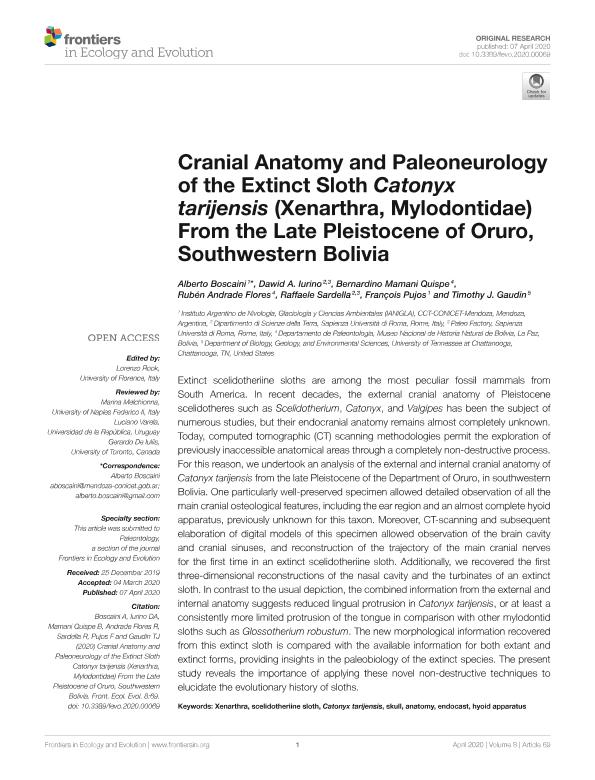Artículo
Cranial Anatomy and Paleoneurology of the Extinct Sloth Catonyx tarijensis (Xenarthra, Mylodontidae) From the Late Pleistocene of Oruro, Southwestern Bolivia
Boscaini, Alberto ; Iurino, Dawid A.; Mamani Quispe, Bernardino; Andrade Flores, Rubén; Sardella, Raffaele; Pujos, François Roger Francis
; Iurino, Dawid A.; Mamani Quispe, Bernardino; Andrade Flores, Rubén; Sardella, Raffaele; Pujos, François Roger Francis ; Gaudin, Timothy
; Gaudin, Timothy
 ; Iurino, Dawid A.; Mamani Quispe, Bernardino; Andrade Flores, Rubén; Sardella, Raffaele; Pujos, François Roger Francis
; Iurino, Dawid A.; Mamani Quispe, Bernardino; Andrade Flores, Rubén; Sardella, Raffaele; Pujos, François Roger Francis ; Gaudin, Timothy
; Gaudin, Timothy
Fecha de publicación:
04/2020
Editorial:
Frontiers Media
Revista:
Frontiers in Ecology and Evolution
ISSN:
2296-701X
Idioma:
Inglés
Tipo de recurso:
Artículo publicado
Clasificación temática:
Resumen
Extinct scelidotheriine sloths are among the most peculiar fossil mammals from South America. In recent decades, the external cranial anatomy of Pleistocene scelidotheres such as Scelidotherium, Catonyx, and Valgipes has been the subject of numerous studies, but their endocranial anatomy remains almost completely unknown. Today, computed tomographic (CT) scanning methodologies permit the exploration of previously inaccessible anatomical areas through a completely non-destructive process. For this reason, we undertook an analysis of the external and internal cranial anatomy of Catonyx tarijensis from the late Pleistocene of the Department of Oruro, in southwestern Bolivia. One particularly well-preserved specimen allowed detailed observation of all the main cranial osteological features, including the ear region and an almost complete hyoid apparatus, previously unknown for this taxon. Moreover, CT-scanning and subsequent elaboration of digital models of this specimen allowed observation of the brain cavity and cranial sinuses, and reconstruction of the trajectory of the main cranial nerves for the first time in an extinct scelidotheriine sloth. Additionally, we recovered the first three-dimensional reconstructions of the nasal cavity and the turbinates of an extinct sloth. In contrast to the usual depiction, the combined information from the external and internal anatomy suggests reduced lingual protrusion in Catonyx tarijensis, or at least a consistently more limited protrusion of the tongue in comparison with other mylodontid sloths such as Glossotherium robustum. The new morphological information recovered from this extinct sloth is compared with the available information for both extant and extinct forms, providing insights in the paleobiology of the extinct species. The present study reveals the importance of applying these novel non-destructive techniques to elucidate the evolutionary history of sloths.
Archivos asociados
Licencia
Identificadores
Colecciones
Articulos(IANIGLA)
Articulos de INST. ARG. DE NIVOLOGIA, GLACIOLOGIA Y CS. AMBIENT
Articulos de INST. ARG. DE NIVOLOGIA, GLACIOLOGIA Y CS. AMBIENT
Citación
Boscaini, Alberto; Iurino, Dawid A.; Mamani Quispe, Bernardino; Andrade Flores, Rubén; Sardella, Raffaele; et al.; Cranial Anatomy and Paleoneurology of the Extinct Sloth Catonyx tarijensis (Xenarthra, Mylodontidae) From the Late Pleistocene of Oruro, Southwestern Bolivia; Frontiers Media; Frontiers in Ecology and Evolution; 8; 4-2020; 1-16
Compartir
Altmétricas



